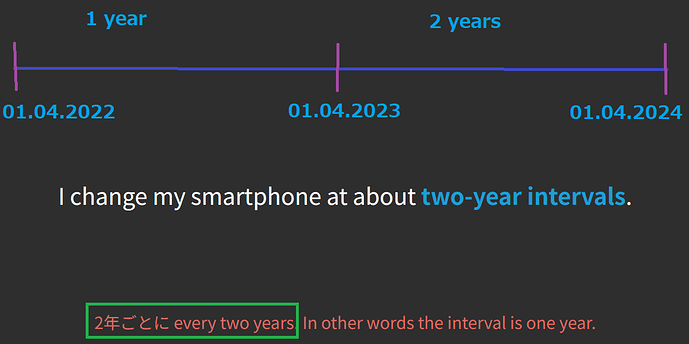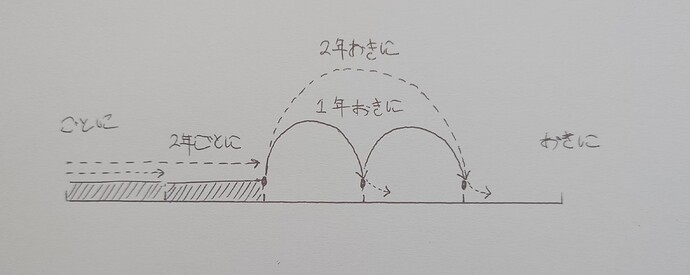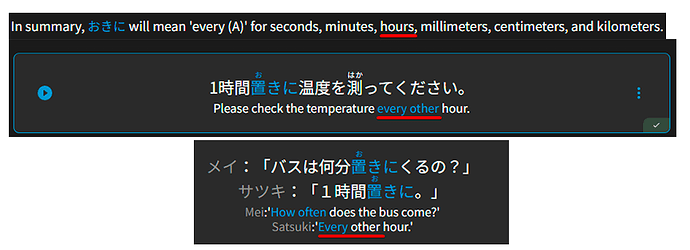I want to suggest a link. The pictures here were really useful to me.
Hello! Has the description been updated recently for this? I just reread it during a review and found lots of information I either forgot or was added in.
There is an example which I think is a typo, but if not, perhaps someone can explain? Towards the bottom it says this:
Continuous variables (things that are usually measured in fractions) - Either ごとに or おきに may be used. For example, seconds, minutes, and hours are usually measured by fractions, especially considering sports and racing. In this case ごとにwill mean ‘every second’, while おきに will mean ‘every opening of one second’ (disregarding all of the milliseconds, this means every second).
- 毎日まいにち2時間じかんおきに体からだを動うごかしている - I move my body every other 2 hours, everyday.
It says “every second” in the explanation but in the example it says “every other.”
Hey there!
We recenlty launched in-house explanations, or Writeups as we call them, for every single N3 Grammar Point. You can read more about that here.
That’s probably where the extra info you’re seeing!
It’s mostly because our translations are based on nuance and meaning rather than being literal! By adding “every other” to the 2 hours, it makes it more casual which is the tone of the sentence.
Hope that makes sense!
Thanks for the message  . Every other and every second may be used the same way in English, although it could be regional as to which is more common.
. Every other and every second may be used the same way in English, although it could be regional as to which is more common.
Every other week and every second week are the same.
I think what they were saying was that it says “every other 2 hours”, which, in English at least, means every four hours - but in a way no one would ever word it.
They are similar, but not the same. Every other 2 hours means there is a two hour break, before something starts, and then continues for the set period of time. Basically continuing in a series of two hours, with 4 hours total. Every 4 hours would mean that something restarts/repeats at the 4 hour mark, not the 2 hour mark.
‘Every other’ is most frequently used with single units though (every other hour, day, week), as it does become confusing with larger numbers, exactly like おきに.
Sorry, I was only talking about the use in English, where every other just means one is skipped. That is, in the first two hours something would happen, then in the next two hours it wouldn’t, then in the third it would happen again, and so on, resulting in an occurrence every four hours overall.
Prompt:
I change my smartphone at about two-year intervals.
My answer:
だいたい2年ごとにスマホをかいかえます。
Error text:
2年ごとに every two years. In other words the interval is one year.
Can someone explain this error text to me? 2年ごとに every two years is not a grammatically complete thought in English, so there’s nothing but more confusion to be had here. Further, for in other words the interval is one year, this second sentence is not anchored to anything, so it’s not clear at all what it’s referring to: the question or my answer.
It seems like the text is insisting “intervals of x” and “every x” mean different things? Does the prompt actually mean “every three years”? I don’t want to insist that my understanding of English is correct, but why trade in such ambiguous language to explain such an equally fraught concept in Japanese? The explanation and question prompts need to be extremely explicit.
I think I understand how this grammar point is used, but am confused by the description; specifically the meaning of the kanji.
The current description:
“ While 置きに may appear to be an adverb, it is actually a combination of 置き, a suffix meaning ‘opening’, and the case marking particle に. 置きに (often without kanji) is an expression used to show that something happens ‘every (A)’, or ‘at intervals of (A)’.
As おきに is technically a suffix, it will be attached to the end of numbers or counters that it is highlighting as being an ‘opening’.”
—-
I have been looking for a dictionary to tell me that 置 means ‘opening’, but only find what I remembered, that being ‘put’ or ‘placement’.
This would actually make some sense if we thought of this as being derived from 置く, making 置き ‘a placing’ and 置きに ‘at placings’. However, the description says ‘opening’, so I’m left wondering if I just have bad dictionaries or if the description might be in error.
I wouldn’t have posted if my alternative theory didn’t make so much sense to me. Please give me any insight you might have about this.
So this is my interpretation of this grammar point:
I’ve read through the explanation, example sentences, links, and what’s in this thread, and what struck me with おきに is that the consistency between the explanations wasn’t what was being directly conveyed (discrete vs. continuous), but the fact that the interval to be skipped is always considered to be discrete and it’s whether or not the event can be considered spanned (i.e, a span of time) or spanless (i.e., a moment/instant in time) that marks the differences. This would explain why some sentences are naturally ambiguous, because some events can be grammatically interpreted as both depending on the context.
So for instance, if you have an event that you do every day that can be considered as a spanless moment in time, such as the time you wake up, feed your fish, etc. where you don’t naturally consider how long it will take, only the instant… then the entirety of that day has no chunk taken out of it from that event as, time-wise, it is dimensionless. Therefore, the discrete unit of the day is fully intact and can be considered as the interval to be skipped, leading to the “every day” usage that we see. Otherwise, if the event is considered to take an amount of time (spanned) for the purposes of the sentence that it’s in, then the discrete unit of the day has a chunk taken out of it and must be discarded entirely with the next discrete unit being used, leading to the “every other day” usage that we see.
This is a somewhat messy, definitely incomplete thought, so I’d appreciate it if someone could tell me if I’m missing anything with my understanding of this grammar point.
Hi,
I am just learning this grammar point, and indeed it is confusing at first !
Thanks to the japanese stack exchange link I think I begin to understand, and then comes the first example sentence :
1時間置きに温度を測ってください
The translation is :
Please check the temperature every other hour
With what I understood, hours are continuous, so when we say 1時間置に, I understand “at interval of 1 hour”, so every hour (there is one hour between, let’s say, 1 pm and 2 pm, right ?)
So why the translation says every other hour, so every two hours ?
I think I am lost here !
I have the exact same question. It also says that it is interchangeable with ごとに in this context, so I assume that it should be every hour instead. I keep getting this grammar point wrong and it’s driving me crazy 

Hi, my teacher (native japanese) told me that it is every hour, yes. Other native people also confirmed this. It is a translation mistake.
With おきに the meaning is always a bit unclear, and 1時間おきに is probably the most unclear case. For either interpretation, you can find native speakers who support it.
I suppose the English translation is wrong in this sentence.
In English, this is what “about every 2 years” = “at about two-year intervals” means:
It does not mean “every 3 years”.
In Japanese, as far as I understand, and very helpful link by FredKore confirms it, this would be either 2年ごとに or 1年おきに
Edit: I don’t know if there are regional differences in English where “intervals of 2 years” = “every 3 years”, but for example this Wikipedia article says “The Olympic Games were held at four-year intervals” Ancient Olympic Games - Wikipedia
I am going to rewrite the explanation for this grammar point tomorrow. I think I figured out what the confusion seems to be here. Ill edit this post again once I’ve made the change  .
.
Edit - Rewrote a big portion of the description. It is longer now (maybe one of the longest on Bunpro  ), but hopefully makes a lot more sense. Basically all you need to remember is that ごとに = ‘sometime during (A), (B)’, while おきに means ‘sometime after (A), (B)’.
), but hopefully makes a lot more sense. Basically all you need to remember is that ごとに = ‘sometime during (A), (B)’, while おきに means ‘sometime after (A), (B)’.
However, as the time/distance gets smaller and smaller, asking when exactly (B) happens becomes stranger and stranger, so おきに will tend toward the assumption of ‘exactly after (A)’.
@casual @nekoyama @Inounx @albcasahu. Feel free to let me know whether this is a better explanation, or worse.
Looking at the example sentences within the description, I like how this one is clarified:
at intervals of one month. (Every second month)
If all test sentences that use the expression “at intervals” would be also clarified like that, that would help. For example:
at two-year intervals (every 3 years)
As is currently, I’m still not sure if you agreed with Eroliene’s and my feedback on that sentence or not. The Japanese one is asking for the answer 2年おきに, which means every 3 years, but the English translation means every 2 years.
Hey,
I will try to give some feedback, but keep in mind that I don’t master perfectly this grammar point !
First, I find that the meaning “sometime during” and “sometime after” are confusing. There is no notion of occurence and repetition. The other meaning you use in the grammar page “every occurence of (A)” for ごとに and “leaving (A) between each occurence” for おきに seems much clearer.
I think that the new explanation is globally more understandable, but this part is still confusing for me :
We can just remember that おきに always has one job. It highlights that (B) occurs after or outside of (A). While ごとに highlights (B) happening within (A).
一秒おきに - The space is ‘one second’, so if おきに points to the beginning of the next second, the space is still only ‘one second’. Because おきに doesn’t care about where (B) happens within that next second, we assume straight away.
五年おきに - The space is ‘five years’, so if おきに points to the beginning of the next year, the space becomes ‘six years’, because we are going to want to know where (B) happens within that next year. It would be strange to assume someone is waiting for New Year of the sixth year to do something instantly.
I don’t understand why your are refering to おきに “pointing to some date/ some moment in time”. It focuses on leaving some time between 2 occurences. As it does not put any constraint on the first occurence, I don’t understand why it would point to some date ?
This is the date/time of the first occurence, that through (A) おきに, will point to the next occurence.
Another thing, I am a bit confused by the “at interval of” translation. I maybe have the wrong meaning here, but for example “at 1 month interval” would mean every month for me (considering that every occurence is separated by one month (duration)). Same for two year interval, that would match for exemple 2022 to 2024 (again, depending on the dates).
I think I begin to overthink this, so I will stop here !
Will fix this. Could even change it to ‘with a gap of’ if that makes more sense (see diagram below)
I drew a quick diagram to show this better. Let me know if it makes it clearer.
With ごとに, it highlights the ‘whole’ time frame, so 一年ごとに says ‘at some point every year, (B) happens’. However, おきに highlight the ‘jump’ or ‘skip’ of one year, and then (B) happens during the second year. so 一年おきに becomes ‘every second year’, when realistically it’s ‘with a space of one year’. Accordingly, 2年おきに will mean ‘every 3 years’, because we jump over two whole years, and then (B) happens in the third.
This is why I wrote that ごとに highlights something happening during (A), while おきに highlights something happening after (A), where (A) is the time or distance.
As you can probably see by the same diagram, when the distance is super small like ‘one second’, that’s where the meanings blur. 一秒ごとに means something is happening every second, during that second. But 一秒おきに will also mean the same, because each ‘gap’ of one second is still only one second. Measuring ‘when’ (B) happens in the second second is too difficult, so it just becomes ‘every second’. The (B) is the little tail I drew coming out of おきに, to show that it happens after the gap.
If this makes the concept easier to understand, let me know and I will alter the description a bit to include ‘with a gap of’, or something similar. It would be good if we could have diagrams on the site, it would make things a lot clearer for some grammar points.



